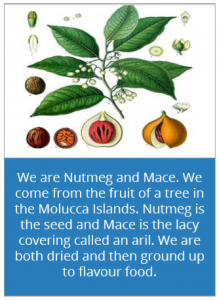We Care About Your Privacy
By clicking “Accept all”, you agree to the storing of cookies on your device to enhance site navigation, analyze site usage, and assist in our marketing efforts. View our Privacy Policy.
This ‘Introduce Me’ activity is a fun and rewarding way to introduce a new topic, while developing language skills.
It’s ideally suited to learners of English, allowing them to hear knowledge presented in different ways, by more than one source, in a non-threatening environment. There’s plenty of opportunity for repetition and rephrasing. This is an adaptable activity to suit any topic where you need to introduce content. This particular example is based on trading goods (see References), but a blank template is provided for you to create your own resource.
The downloadable history cards allow children to take on the role of different ‘goods’ traded by the East India Company or the Hudson’s Bay Company from the 1600s. The children, pretending to be ‘goods’, must meet each other and present themselves in their roles.
The activity uses the ‘Introduce Me’ technique: the children read, memorise and represent information to others, who may then present this themselves to new audiences. Full instructions are provided on the downloadable resource.
Collaborative learning:
- makes challenging curriculum accessible
- improves social relations in the classroom
- provides scaffolding for exploratory talk
If you can't talk it through with others, you won't be able to write it confidently!
We are Collaborative Learning – a network of teachers who develop and disseminate ‘talk for learning’ activities across all subject areas and for all ages.
Our activities are based around the skill of ‘oracy’ – a word originally coined by Andrew Wilkinson, author of Spoken English. Andrew felt that ‘oracy’ matched ‘literacy’ as a skill to be nurtured and developed. He argued that the opportunity to develop confidence in speaking and listening was lacking from the state education system. More recently, research has revealed the importance of the role of talk in developing literacy and in building neurological pathways in the brain.
To encourage oracy, we’ve helped to develop collaborative group work in schools both in the UK and abroad. We started in classrooms where children didn’t possess the cultural capital or the skills to conduct conversations about the curriculum. Many of them, in addition, were learning English at the same time as acquiring curriculum knowledge.
Our activities help children conduct a discussion around a curriculum topic. Children learn to listen carefully to what others have to say and to respond in an articulate and persuasive way. Here’s an explanation of just how our role-play, hot-seating and ‘Introduce me’ activities work: Click here.
At Collaborative Learning, we integrate oracy with curriculum knowledge. Here’s an example of how that works in practice, with a resource which we hope you’ll find useful.

In the resource, you’ll find a set of downloadable cards allowing children to take on the role of different ‘goods’ traded by the East India Company or the Hudson’s Bay Company from the 1600s. The children, pretending to be ‘goods’, must meet each other and present themselves in their roles.
The activity uses the ‘Introduce Me’ technique: the children read, memorise and represent information to others, who may then present this themselves to new audiences. In the process, the information is transformed into personal knowledge.
The activity is particularly helpful for children who are in the early stages of learning English. They’re able to hear knowledge presented in different ways, by more than one source, in a non-threatening environment. There is opportunity for repetition and rephrasing, further developing language skills.
It’s important to note that the role-play cards found in the resource are historically based: they reference events and practices from the past, such as slavery. You can create your own, customisable role-play card by downloading our template resource.
Our collaborative activities are fluid and flexible. Teachers share them on the network for others to use: they can be tweaked to suit your particular curriculum and language development needs. Above all, they’re designed to promote and scaffold purposeful talk and sustained shared thinking.
We hope that you will join our network and contribute your collaborative work for others in turn. You’ll be in good company – there’s a new interest in oracy and group-work nationally, which we trust will grow and strengthen. For more information on initiatives such as the Cambridge oracy network, the English and Media Centre (which promotes group work) and Partnership Teaching (which encourages teachers to work together to devise resources and share good practice), see our Links page.
References:
KS2 National Curriculum: the curriculum requires pupils aged 7-11 years to study ‘an aspect of British history that extends…chronological knowledge beyond 1066’. The activity in this resource focuses on ‘trade’ post-1066. It also anticipates the KS3 curriculum theme of ‘ideas, political power, industry and empire’ (for 11-15-year-olds).
Wilkinson, A (1965), Spoken English, University of Birmingham
Assessment is a natural and integral part of effective teaching, with teachers continually assessing learner progress and identifying next steps for teaching and learning (DfE, 2020). Teachers assess learners for multiple reasons but one of the most pressing tasks for teachers is to assess their newly-arrived EAL learners’ level of English proficiency.
AI technology can offer adult learners of English or multilingual families a supportive, fun and engaging environment in which to learn and practise their English. Schools can play an instrumental role in guiding those families through this process and therefore home-school collaboration is always encouraged. Let’s look at four different ideas for school staff to encourage their multilingual families to engage in an enjoyable language learning experience through AI.
When striving to engage parents of EAL learners in an Early Years setting, we must be mindful to provide extra sensitivity and inclusivity. As well as potentially struggling with the language barrier, this may also be their own and their child’s first experience of a UK-style school, which may be very different to what they grew up with in their home country.